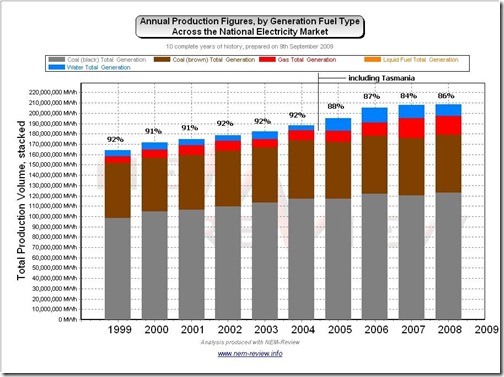Yesterday I attended an EUAA-organised event, at which Dr Perry Sioshanshi (American consultant and industry commentator) was the main speaker. The topic:
U.S. Climate Change and Energy Policy Report
– Recent Developments and Implications for Australia
Key Notes
Perry spoke for a long time (and who could blame him, as the subject is a complex one of great interest to many).
His most telling comment was at the end, when he noted that (unlike the President Kennedy’s exhortation to put a man on the moon within a decade) this problem is one that is significantly more complex, as it has no single owner who can galvanise such action. This reminded me of Ross Garnaut’s labelling of the issue as “a Diabolical Problem”.
Some of the other comments that Perry made that I found particularly noteworthy:
1) He contrasted the recent passage of the Waxman-Markey bill in the US (reading more than 1000 pages) with California’s own legislation for reduction of carbon emissions (which he noted was very short – something like 15 pages). Perry made the point that the lobbying process had created a monster that, despite several attempts to read:
(a) Was not yet possible for him to understand in full; and
(b) Appeared contradictory in places.
Perhaps this is what bodes for Australia with its CPRS legislation, if it ever gets through?2) Perry noted the clear distinction in the level of support between the states with low-intensity electricity (and coincidentally much higher delivered prices) and the states in the middle of the country with coal-based, low-priced electricity. Again, an indication of the conflict that will be inevitable in any international agreement.
3) Perry also noted that the US Supreme Court had (a couple of years ago) declared carbon dioxide a pollutant and hence implied that President Obama could (if negotiations came unstuck) choose the option of regulating emissions through the EPA in any case – as was done with SOx
4) In the proposed legislation, Perry noted that conventional coal plants would be permitted to be built up until 2020, so long as the plants were to refit with CCS technology when “commercially available” (whatever that means).
5) In terms of international perception, it was clear that Australia’s 5% by 2020 target was perceived as very modest, compared to stated objectives of other OECD countries. Appears that Australia has a PR issue, in relation to its attempts to highlight reductions on the basis of Business-As-Usual projections (again, whatever that means in reality).
6) Finally, Perry gave a plug for a new book he has edited titled “Generating Electricity in a Carbon Constrained World”, which contains a chapter about all the main and proposed new technologies (with each chapter authored by a supporter of that particular technology). Sounds like interesting reading.
Hope this is of some interest
Mix of Generation Plant in the NEM
During his presentation, Perry asked me about the current mix of generation (by fuel type) across the NEM.
To present a fuller answer to this question, I thought it would be of interest to present the following chart, which I have sourced from our NEM-Review software.
Note in this analysis, I have left off the 2009 calendar year as it is only part-complete. I have also omitted wind production from the chart as the amounts are negligible, in terms of the total energy produced.
I have also annotated the bars in each year to indicate the percentage of production (in that year) attributable to coal (both black and brown). In this way, we can clearly see that the entry into the NEM of the Tasmanian hydro system in mid-2005 had the effect of diluting the percentage of the market (albeit larger) supplied by coal.
In more recent times, we can also see an expansion in the amount of gas-fired capacity, supported by climate concerns (and also shifts in the cost of capital), plus the effects of generation switching during 2007 as a result of the drought.



Be the first to comment on "Thoughts on a “Diabolical Problem”"